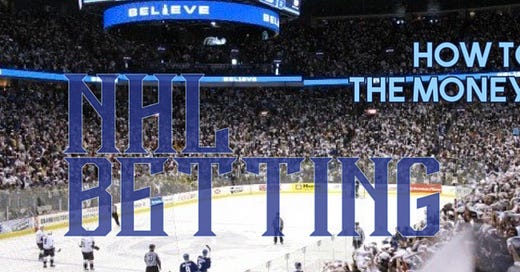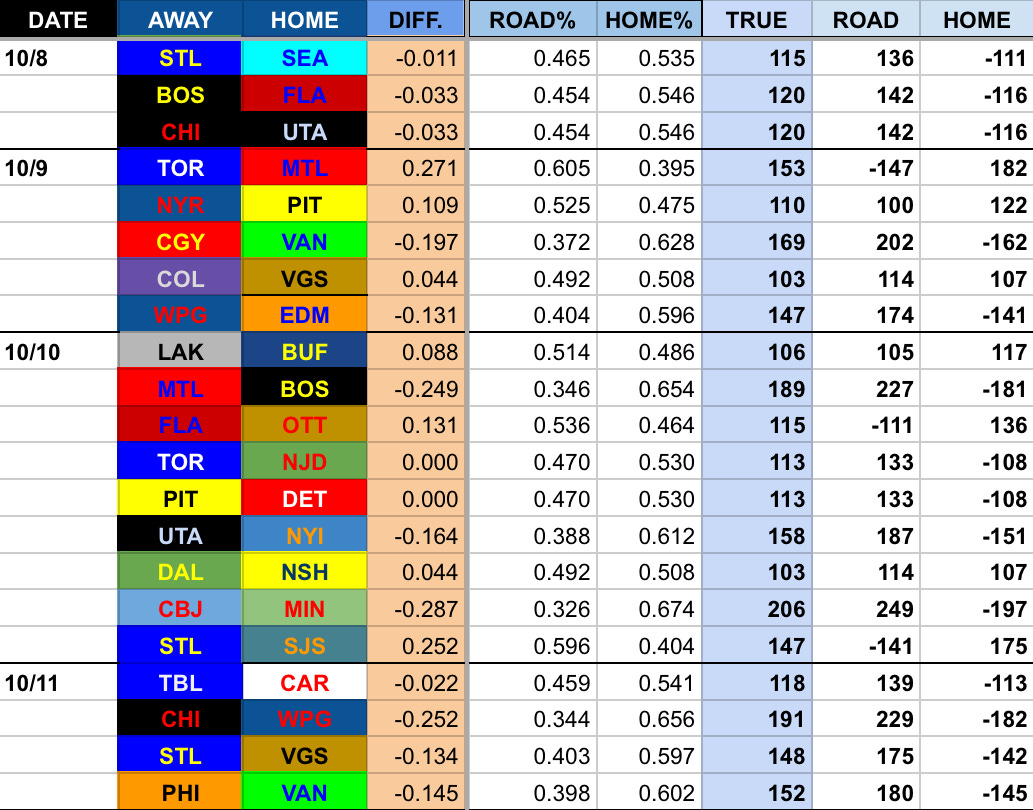Matt Russell is the creator of THE WINDOW, and former lead betting analyst at theScore. If there’s a bad beat to be had, Matt will find it. You can find him @mrussauthentic on X.
Pop quiz: If two purely-average NHL teams faced each other on neutral ice - maybe a frozen pond in Northern Alberta - who would be favored?
The answer is, of course, no one.
Each team is 50% likely to win. In the same way any two teams that are equally rated are equally likely to win.
The sportsbook offers up each side at -110:
One team wins, returning $100 to their bettors, while keeping $110 from those who bet on the loser
The betting public bets $220 and keeps $210
On average, the sportsbook keeps 4.5% of all money wagered
The NHL has the puck line - favoring a team by 1.5 (sometimes 2.5) goals - but rare is it that anything is priced in a balanced way like the point spread is for football and basketball.
In those sports, price shopping for the best point spread (ie. Getting +6.5 (at -110) versus betting an underdog at +5.5) can directly affect whether you win or lose.
In hockey (like baseball), betting on the moneyline at -140 or -160 doesn’t change whether you win or lose a bet. However, in these high-volume sports with dozens of games per week, getting the best price adds up over time.
A .500 record on the season (eg. 100 wins and 100 losses) on moneyline bets, averaging +120, wins you $200 on $10-unit bets. Going 100-100 on moneyline bets with an average of +140 odds nets you $400. Price matters.
If you like to bet the favorite, you need to win 60% (120-80) of your bets if the aberate moneyline is -150. If you go 120-80, but your average moneyline bet is -140, you’ll be up $80.
The vast majority of hockey games have different moneyline odds at various points between the time they open the night before, until the puck drops at 7:05pm local time on game day.
The best hockey bettors stay on top of the moneyline movements to save themselves money on a favorite and get the best payout possible on an underdog.Who wants to have some fun?!
Stop what you’re doing and grab a pencil and paper, or more likely, open up a spreadsheet and list the NHL teams in your order from best (No. 1) to worst (No. 32)
What does it mean to find value on a hockey game?
Somewhat frustratingly for new hockey bettors, both teams can be a valuable bet for any given game.
Since only one can eventually win, this can be a tough concept to grasp.
A hypothetical:
Think about equally-rated teams, playing in Europe somewhere on a Tuesday night.
Each team has a 50/50 chance to win, but when the odds open on Monday night, what if early money comes in on Team A at -110, so much so that the odds change and Team B is now available for +110.
A bet on Team B means you’re getting a team that’s 50% likely to win at a price that suggests they win just 47.6% of the time. That’s a 2.4% discount or “edge” on our fair price.
Then the next day, so many people like the idea of getting Team B at plus-money, as limits increase they bet Team B to where they’re now a small favorite, and a half hour before puck drop Team A is +110. They’re now the valuable bet!
It gets more complicated when a matchup is not a 50/50 proposition. What if we determine one team is 60/40 to win?
The fair price is -150 for the favorite and +150 for the underdog. Ideally, we’d like the favorite at odds shorted than -150, or the underdog at odds longer than +150.
“Ok, all of that makes sense, but how do we know what those percentages should be in the first place, before we compare them to the odds offered?” - You, probably
How do moneylines work in hockey?
For starters, knowing how the market has felt about a team helps.
As we broke down for the NFL, a good starting point is using information from a market where bettors have had an extended period of time to weigh-in and form a consensus. In football, regular-season win totals are up for months, and a team lined at 8.5 wins is expected to be .500 team.
For the NHL, you can bet on regular-season point (RSP) totals. The 3-point game in the NHL complicates things a bit, but “.500” for an NHL team is around 91.5 points.
This year? That’s the Islanders.
The team with the highest RSP for 2024-‘25? The Oilers, who are set at 108.5. That total considers Edmonton 19% above average.
The team with the lowest RSP? The Sharks, who are set at 63.5. That total considers San Jose 30.5% below average.
Since it’s easier to be really bad than really good.
If the Sharks played the Oilers, the gap between the two (~50%) would be reflected in the implied win probability (IWP). The Oilers are 75% to win, while the Sharks are 25%. Translating that to a “true” moneyline makes Edmonton -300 and San Jose +300.
What about home-ice advantage?
Yep, next is the application of home-ice advantage.
Based on recent years, home teams win about 53% of all hockey games, and therefore 3% should shift from the road team’s IWP to the home team’s.
If the Oilers played the Sharks at home, Edmonton now becomes 78% (-355) to San Jose’s 22% (+355).
The sportsbooks haven’t taken their share yet, have they?
Nope. Per our example above, sportsbooks are looking to take 4-5% of every equal bet on each side, so they swoop in to add 4-5% to the implied win probability of the game’s pricing.
For our Sharks-Oilers example - since bettors like betting favorites, oddsmakers might be more likely to add a tax on Edmonton, making you pay for them like they’re 83% (-485 on the moneyline) likely to win, when it’s really 78%.
Will that matter to those betting on Edmonton? Not if they win, but there’s about a 22% chance it does matter, and on those instances where the favorite loses, it means you lost 4.85 units when you should have lost “only” 3.55.
“Matt, I would never lay that high of a moneyline in a hockey game! Anything can happen!” - You
“Ok, sure, but you’re tempted to throw it in a parlay, which makes you feel like you’re not laying it, but I’m here to remind you, YOU ARE still paying that price. In fact, that 5% tax you’re paying? Every time you add a leg to a parlay, you’re adding more tax to a bet! Why do you want to pay so much tax, Gary?! - Me
How do we define value?
We have a guess on a final moneyline market on the Sharks (+355) and the Oilers (-485), and if that’s the actual market, there’s nothing to do. San Jose has a fair price to win, but that’s not enough to get us to pull the trigger on a massive underdog, and it’s not responsible to pay that much for the Oilers.
But, as you know, the market may move, and the moneylines may change.
We need guide rails on how to define value.
Here are mine (approximately):
1% edge on a favorite (-125 or higher)
2.5% edge on a short favorite or underdog
4% on a sizeable underdog
We’ve decided that the Oilers are 78% likely to win, so if they’re priced at 77% or -334, they’d be a valuable bet.
Personally, I’d still be nauseated by the idea of laying 3.34 units in a hockey game, so I’d likely still pass.
We’ve decided the Sharks are 22% likely to win, so if they’re priced at 18% or +455, then it would be time to bite the bullet for a bet on San Jose.
With every other matchup the same math equation is done, with the same thought process, just at more palatable prices.
While we wouldn’t expect to win with the Sharks at +455, the idea is that if we make a bet with a 4% edge, we’ll be profitable long-term by going 22-78 on that bet.You still haven’t told us how YOU determine what your price would be
True. Our example above is based on the market’s opinion of the Sharks and Oilers, and every other team in the NHL. What about my/your/our opinion?
For starters, you can look at the other teams’ rating, and decide which teams are overrated or underrated.
Remember how I suggested making your own list?
Compare your list with the market rating chart below, and for the first few weeks:
Have a team ranked higher than the market? Bet them in a game against a team you don’t.
Have a team ranked lower than the market? Bet against them against a team you don’t.
NHL Market Ratings
Dude, seriously, your method! Please!
When doing your own ratings for teams in any sport, it’s important to build them off of SOMETHING. Ideally, they would be based on something you believe is the most important to winning games, and supported by metrics to back that up.
I’m not going to give away my calculus, but here’s what I believe:
If you’re good at even-strength, the rest will follow:
Creating more high-danger chances and expected goals than the opponent will (more often than not) result in more actual goals long-term
Dominating at even-strength will create more power plays and, at least, level the playing field against teams with better special teams
On average, a 20% power play that gets five chances scores one goal
On average, a 25% power play that gets four chances scores one goal
Limiting opponents’ chances will improve the quality of a team’s goaltending
Goaltending is the most difficult position to predict year-to-year, and game-to-game, and the market often overreacts to a team’s backup starting
When given a somewhat-rare opportunity, backup goaltenders can perform just as well as the starter - who may consider a regular season start to be “just another game”
Teams often play harder knowing the backup goaltender is in net
Relying on even-strength metrics and not getting too caught up in long-term goaltending statistics for short-term, single-game bets is how I build my ratings.
Then it’s a matter of a few steps:
Use those ratings to create an estimated implied win probability for each matchup
Convert moneyline odds offered by the sportsbook into an implied win probability
Compare our price to the odds
If there’s a suitable difference (and no reason to pass), bet it
Knowing how the market feels about a team allows us to have an idea of when to get the best price. If the Maple Leafs are hot, betting them early or fading them late is a good example of timing the market. The plan at THE WINDOW
What I will do for the first few months of the NHL season, is include moneyline projections, or “prices to bet” each side of every game, as part of the podcast email twice per week.
Tuesday’s podcast email will have the games for Wednesday to Friday
Friday’s podcast email will have the games for Saturday to Tuesday
It will be up to you to price shop, and whether or not to bet each side.
NHL moneyline betting guide
To celebrate NHL Opening Night, here’s the first edition of the NHL moneyline betting guide:
Once football season dies down, we’ll turn the focus to the NHL on a more regular basis, before the break for the 4 Nations Face-Off. Then when the NHL returns on February 22nd, we go hard until the Stanley Cup is raised in June.







